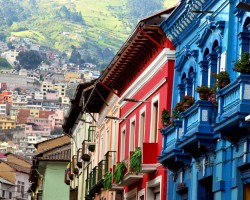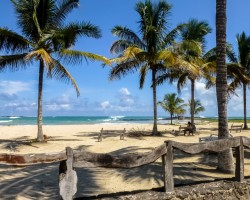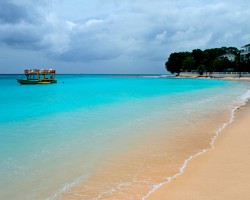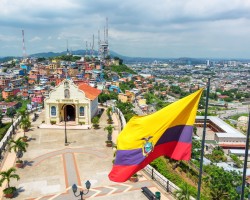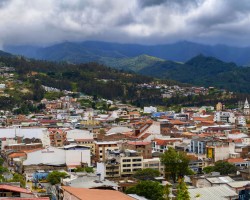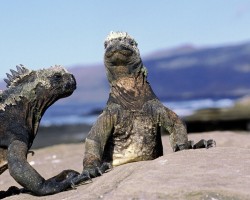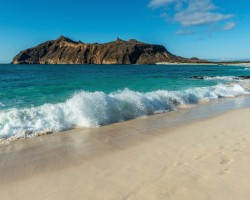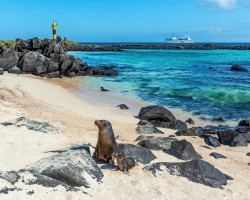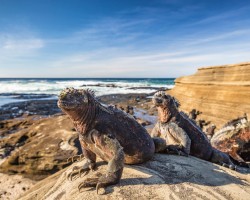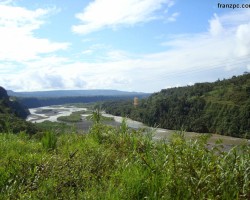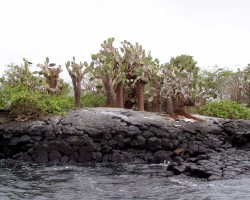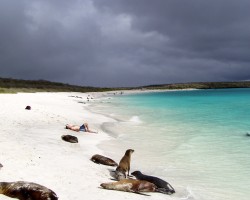Best time to go to Ecuador for a perfect weather and where to go?
When is the best time to go to Ecuador?
The best time to travel to Ecuador generally extends from June to December. However, it is entirely possible to consider a trip all year round and to adapt your itinerary in Ecuador according to the seasons and experiences you want to have on site.
Therefore, to enjoy the beautiful beaches along the Pacific coast, on the west side of Ecuador, there's nothing like the period from May to December. Indeed, the sun is shining for lounging on the beach or observing the local wildlife. If you dream of seeing humpback whales in the Santa Elena region, the ideal time is between June and September. Outside of this dry season, the coastline is perfect for surfing around Manta. When is the best time to visit Ecuador to avoid crowds of tourists on the Pacific coasts? Opt for the months of May and June, therefore outside of European school holidays.
But, to visit the capital Quito and its surroundings, the best time is between June and September. It is the high tourist season in the highlands, so it is better to book your accommodation in advance. Sports enthusiasts as well as culture lovers flock to the region, either for climbing or for visiting tourist sites.
Nature lovers, on the other hand, can visit the Oriente and go to the Ecuadorian Amazon jungle in August or September, when the rains are moderate. The rest of the year, the weather is less favorable, as it is more humid, but a stay is still possible, except in February and March, which are the rainiest months.
Finally, the Galápagos Islands can be discovered all year round, but the best season is (paradoxically) the wet season from November to May. The showers are short and the heat is comfortable! The archipelago will then reveal all its assets, between endemic fauna and the possibility of water activities, such as scuba diving.
What to pack in your suitcase for a trip to Ecuador? Regardless of the season, remember to bring warm and waterproof clothing. Depending on where you are going, it can be cool in the evenings and showers are always a possibility. Likewise, if you plan to hike in the Andes, make sure to bring good walking shoes. The rest of your luggage should include light but covering clothes to avoid mosquito bites, a good repellent, as well as everything you need to protect yourself from the sun: a hat or cap, suitable sunglasses, and sunscreen that meets European standards.
Where and when to go based on the weather?
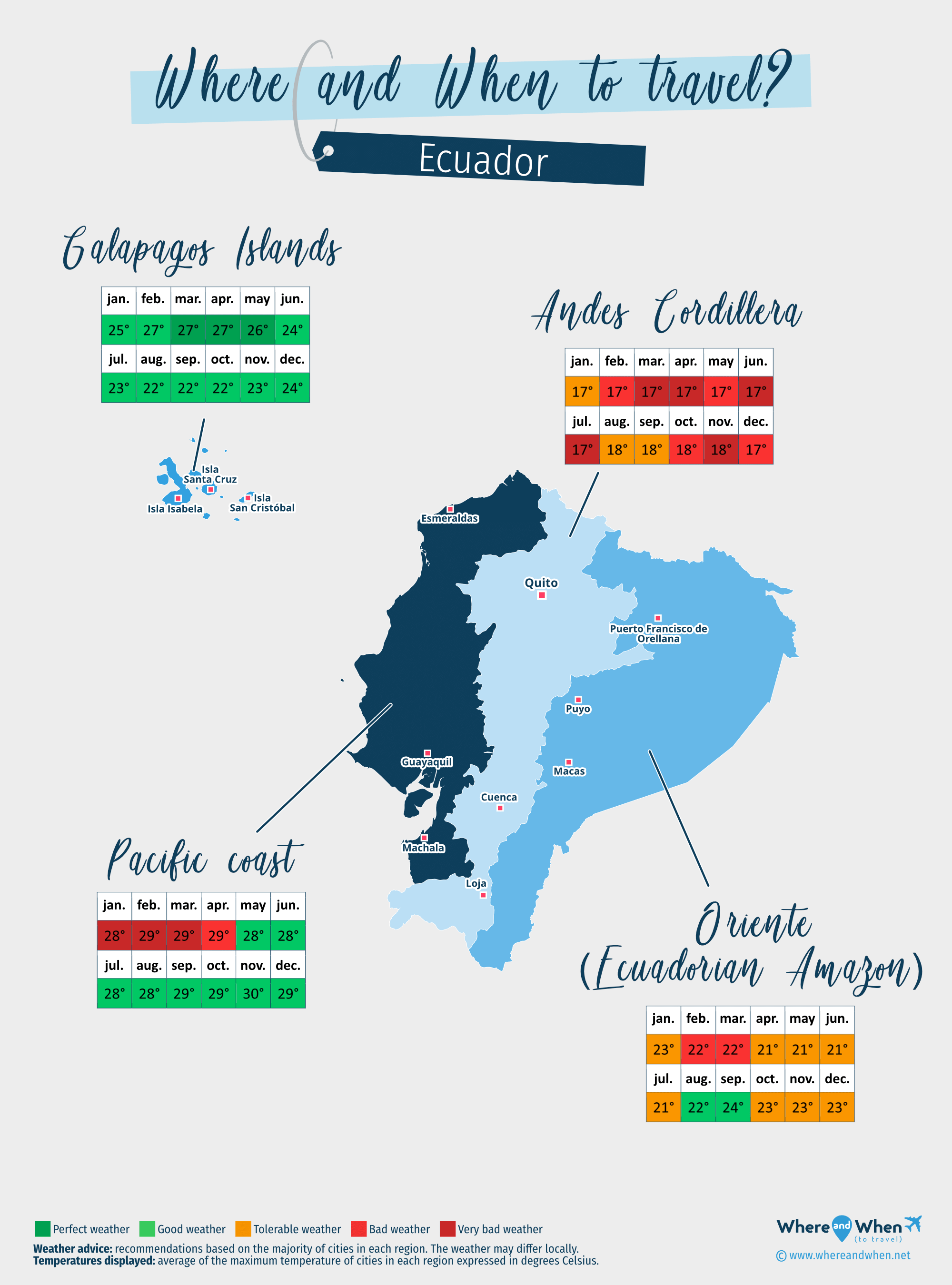
Andes Cordillera
Quito, Cuenca, Loja...
Galapagos Islands
Isabela Island, Santa Cruz Island, San Cristóbal Island...
Oriente (Ecuadorian Amazon)
Puyo, Puerto Francisco de Orellana, Macas...
Pacific coast of Ecuador
Guayaquil, Esmeraldas, Machala...
To get all the information about the climate and weather in Ecuador for a specific month, click on the corresponding link below:
Ecuador in january Ecuador in february Ecuador in march Ecuador in april Ecuador in may Ecuador in june Ecuador in july Ecuador in august Ecuador in september Ecuador in october Ecuador in november Ecuador in december
Best time to travel to Ecuador by cities
Climate and Weather in Ecuador
Located between Peru and Colombia, the country experiences large climatic variations and the weather varies depending on the altitude and regions. Thus, it is not uncommon to see very changeable weather in the same day. The predominant climate in Ecuador is tropical, ranging from savanna to dry winter, as seen in the region of Guayaquil. However, this is tempered in part due to the presence of the Andes mountain range, and there are several other climate trends:
- An oceanic and temperate climate found in the capital, Quito, and its surroundings.
- A hot and dry steppe climate in the vicinity of Huaquillas, in the extreme south of the country, as well as in the Galapagos archipelago.
- A Mediterranean and temperate climate is present around Tulcán, near the Colombian border.
- As for the Oriente, the Amazonian part of Ecuador, it experiences an oceanic climate, but also an equatorial one, with abundant rainfall and a constant temperature throughout the year.
There are two main seasons in Ecuador:
- The rainy season (or winter) usually starts in November and ends in May, with generally warm and rainy weather.
- The dry season (or summer) is much shorter, beginning in June and ending in October. It is the coolest period in Ecuador.
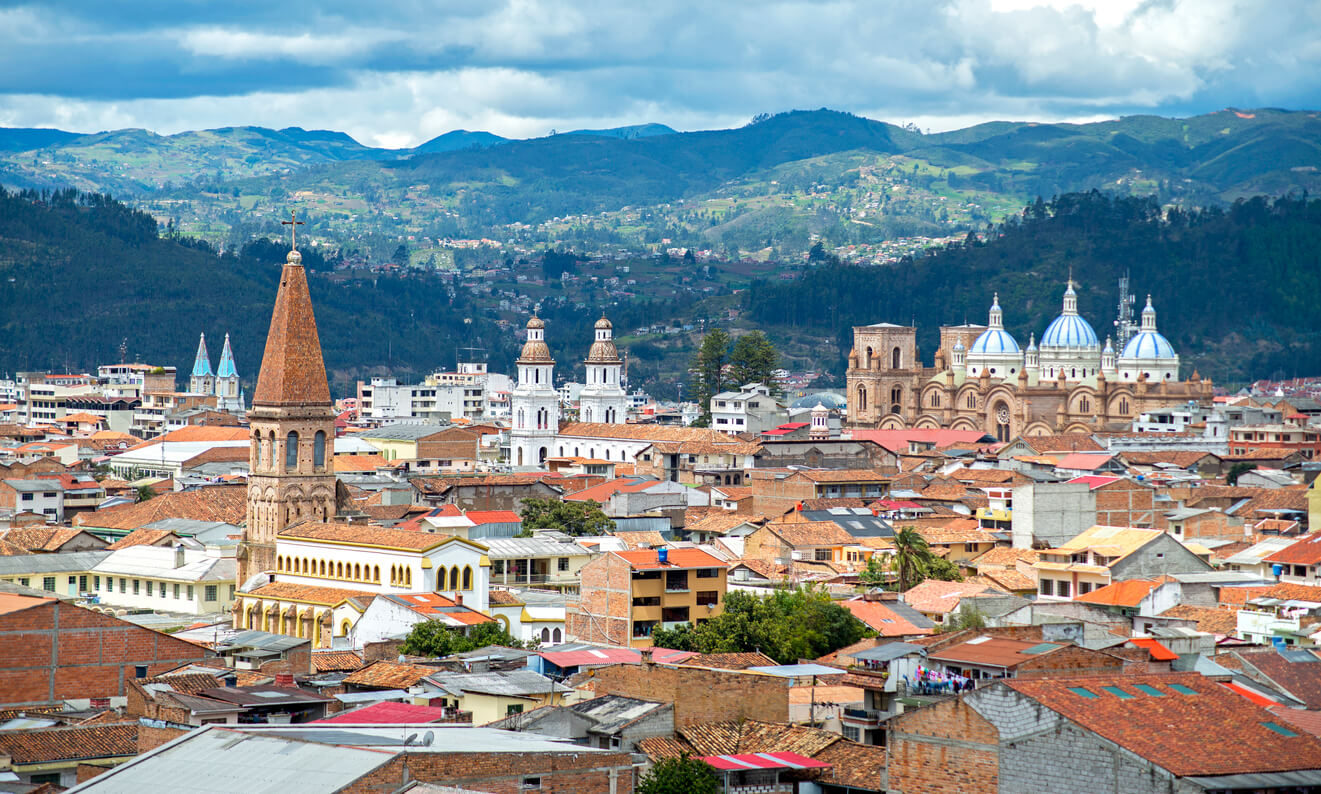
Climate in the Andes Mountains (La Sierra)
In the Sierra, the weather in Ecuador varies greatly depending on the altitude. The higher you go, the colder it gets. The best months to explore the region are January, August, and September.
The rainy season lasts from October to May. Temperatures are lower than in the rest of the country, especially in high areas. It averages around 26°C (79°F) during the day and 14°C (58°F) at night. Depending on the year and location, it can rain between 10 and 29 days per month.
During the dry season, from June to September, the Andes Mountains experience a pleasant temperate climate and the sun shines most of the time. The only downside is that the peaks can experience particularly strong high-altitude winds, as in Quito for example. Temperatures remain consistent compared to the wet season, but rainfall is much less frequent.
Climate of the Pacific Coast
The Ecuadorian Pacific coast experiences more pleasant and mild temperatures than the Sierra region and can be visited under the best conditions between May and December.
Temperatures are fairly stable throughout the year: between 31 and 34°C (94°F) during the day and between 22 and 27°C (81°F) at night, with the coolest months being from May to August. The most intense rainfall occurs between January and March, with up to 26 days of rain per month.
Surprisingly, it is during the dry season, from June to October, that the sun is least common. Indeed, this area is regularly covered by a thick mist throughout the day, also known as garúa.
It is rather during the rainy season that one can enjoy the beach and sun of Ecuador, as the showers are short-lived. The best time to visit this part of the country is in November and December, as all conditions are met for an idyllic stay with rare rains and water temperatures around 25°C (77°F) .
Climate in the Ecuadorian Oriente
The Oriente region corresponds to the Ecuadorian Amazon. Here, like in neighboring Peru, the weather is rather hot and humid, with particularly heavy rains throughout the year. There is, however, a (slightly) drier season between July and September. Temperatures, on the other hand, remain almost the same throughout the year: from 28 to 33°C (92°F) depending on the month. The temperature range is quite significant, as nights remain quite cool with lows between 13 and 15°C (59°F) .
Climate in the Galapagos Islands
Located in the heart of the Pacific Ocean, nearly 1000 km from the Ecuadorian coast, the Galapagos Islands have their own microclimate, influenced by the different ocean currents present, especially the Humboldt current, which cools the area.
The archipelago can be visited all year round, but temperatures are more pleasant during the rainy season, from November to May. In reality, it rains very little (maximum 7 days of rain per month in February) and temperatures range between 23 and 28°C (83°F) . This is also when the Pacific water is most suitable for swimming and various marine activities as it can reach 27°C (81°F) at the peak of the season.
During the dry season, from early June to early December, temperatures remain fairly mild, between 21 and 25°C (77°F) , but while precipitation is almost nil, a thick permanent fog appears on the top of the islands during this period.
Temperatures and rainfall in Ecuador
On these 3 graphs, we present the evolution of temperatures of Ecuador and month-by-month rainfall for the cities of Quito, Isabela Island, Cuenca, Guayaquil and Loja, as well as the month-by-month sea temperature for coastal cities.

Peak visitor numbers and tourist seasons in Ecuador
Find out when Ecuador has its high tourist season (the period when the influx of tourists is highest) and off-peak tourist season using our data and figures.
Tourist seasons in Ecuador
The months with low numbers of tourists are: January, February, March, April, May, June, September, October and November. The number of visitors to Ecuador is high in: July, August and December.
- Very low season in Ecuador: January, February, April, May, June and September.
- Low season in Ecuador: March, October and November.
- High season in Ecuador: July and December.
- Peak season in Ecuador: August.
Figure: Visitor index for Ecuador month by month
Average price for flights to Ecuador
A return flight between Montreal and Quito is generally cheaper if you go in may ($ 501 on average): this is the best time for travellers on a tight budget. In contrast, you may end up paying $ 125 more for your airline ticket to Quito if you go in december.
Where to go in Ecuador?
This table allows you to see the maximum temperature for each city and our opinion on the weather month by month (see colour legend below the table).
| Cities | jan. | feb. | mar. | apr. | may | jun. | jul. | aug. | sep. | oct. | nov. | dec. |
| Quito | 63°F | 63°F | 63°F | 63°F | 63°F | 65°F | 65°F | 67°F | 67°F | 65°F | 63°F | 63°F |
| Isabela Island | 79°F | 81°F | 83°F | 81°F | 79°F | 77°F | 76°F | 74°F | 74°F | 74°F | 74°F | 76°F |
| Cuenca | 63°F | 63°F | 63°F | 63°F | 63°F | 61°F | 61°F | 63°F | 65°F | 65°F | 65°F | 63°F |
| Guayaquil | 90°F | 88°F | 90°F | 90°F | 90°F | 88°F | 90°F | 92°F | 94°F | 94°F | 94°F | 92°F |
| Loja | 72°F | 70°F | 70°F | 70°F | 70°F | 68°F | 68°F | 70°F | 72°F | 74°F | 74°F | 74°F |
| Floreana Island | 79°F | 81°F | 83°F | 81°F | 79°F | 77°F | 76°F | 74°F | 74°F | 74°F | 74°F | 76°F |
| San Cristóbal Island | 79°F | 81°F | 83°F | 81°F | 79°F | 76°F | 74°F | 72°F | 70°F | 72°F | 74°F | 76°F |
| Santa Cruz Island | 79°F | 81°F | 83°F | 81°F | 79°F | 77°F | 76°F | 74°F | 74°F | 74°F | 74°F | 76°F |
| Santiago Island | 79°F | 81°F | 83°F | 81°F | 79°F | 77°F | 76°F | 74°F | 74°F | 74°F | 74°F | 76°F |
| Esmeraldas | 83°F | 83°F | 83°F | 85°F | 85°F | 83°F | 83°F | 83°F | 83°F | 83°F | 83°F | 83°F |
| Macas | 70°F | 68°F | 68°F | 68°F | 68°F | 67°F | 67°F | 70°F | 72°F | 72°F | 72°F | 70°F |
| Machala | 85°F | 85°F | 85°F | 85°F | 85°F | 83°F | 81°F | 81°F | 81°F | 81°F | 83°F | 83°F |
| Puerto Francisco de Orellana | 88°F | 88°F | 86°F | 85°F | 85°F | 83°F | 85°F | 90°F | 92°F | 90°F | 90°F | 88°F |
| Puyo | 70°F | 68°F | 68°F | 68°F | 68°F | 67°F | 67°F | 70°F | 72°F | 72°F | 72°F | 70°F |
| Baltra Island | 79°F | 81°F | 83°F | 81°F | 79°F | 77°F | 76°F | 74°F | 74°F | 74°F | 74°F | 76°F |
| Española Island | 79°F | 81°F | 83°F | 81°F | 79°F | 76°F | 74°F | 72°F | 70°F | 72°F | 74°F | 76°F |
| Fernandina Island | 79°F | 81°F | 83°F | 81°F | 79°F | 77°F | 76°F | 74°F | 74°F | 74°F | 74°F | 76°F |
| Baños | 58°F | 58°F | 58°F | 58°F | 58°F | 56°F | 56°F | 58°F | 59°F | 59°F | 59°F | 58°F |
| Manta | 83°F | 83°F | 85°F | 85°F | 83°F | 83°F | 81°F | 81°F | 81°F | 81°F | 81°F | 81°F |
| Azogues | 63°F | 63°F | 63°F | 63°F | 63°F | 61°F | 61°F | 63°F | 65°F | 65°F | 65°F | 63°F |
Legend:
perfect weather
good weather
tolerable weather
bad weather
very bad weather
About Ecuador
What can I do in Ecuador?
Beaches / swimming
Nature and countryside
Culture and heritage
Sports
Family travel
Crafts / shopping
Gastronomy
Nightlife
Is this weather information for Ecuador reliable?
Climate data for Ecuador has been gathered every day since January 2009. The analysis of these meteorological data for Ecuador allows us to determine the average for each month in Quito, Isabela Island, Cuenca, Guayaquil, Loja, Floreana Island, San Cristóbal Island, Santa Cruz Island, and 38 other cities.
So yes: this data is reliable except in cases of temporary climate disruption in the region.

